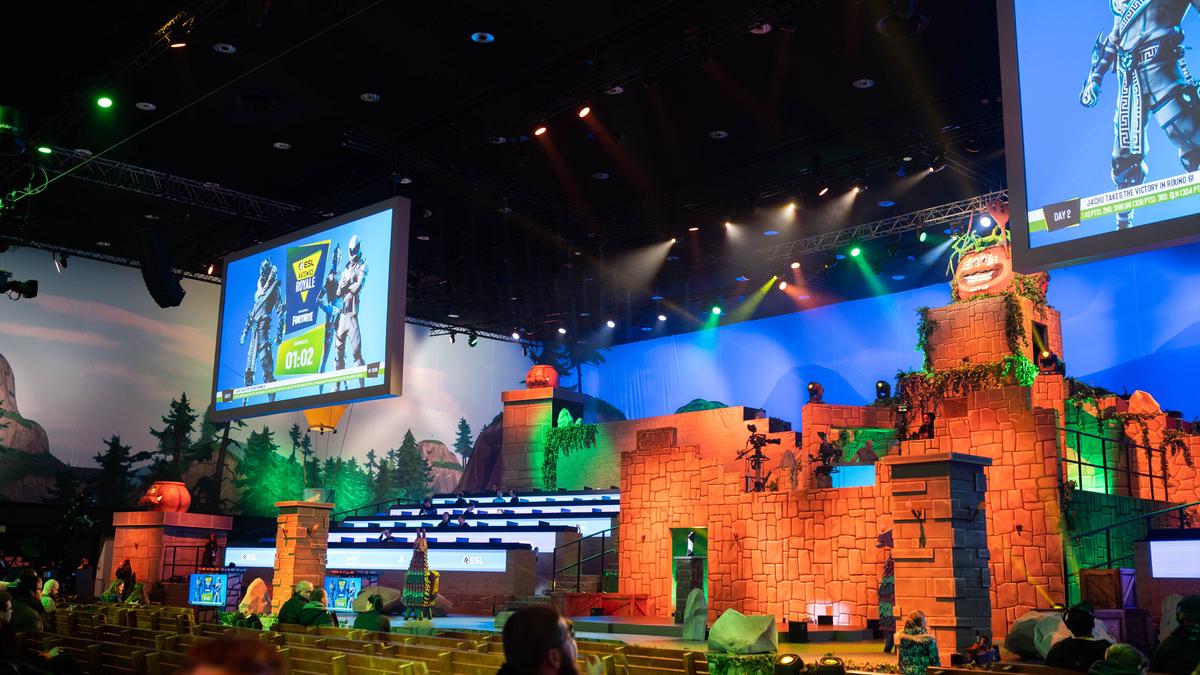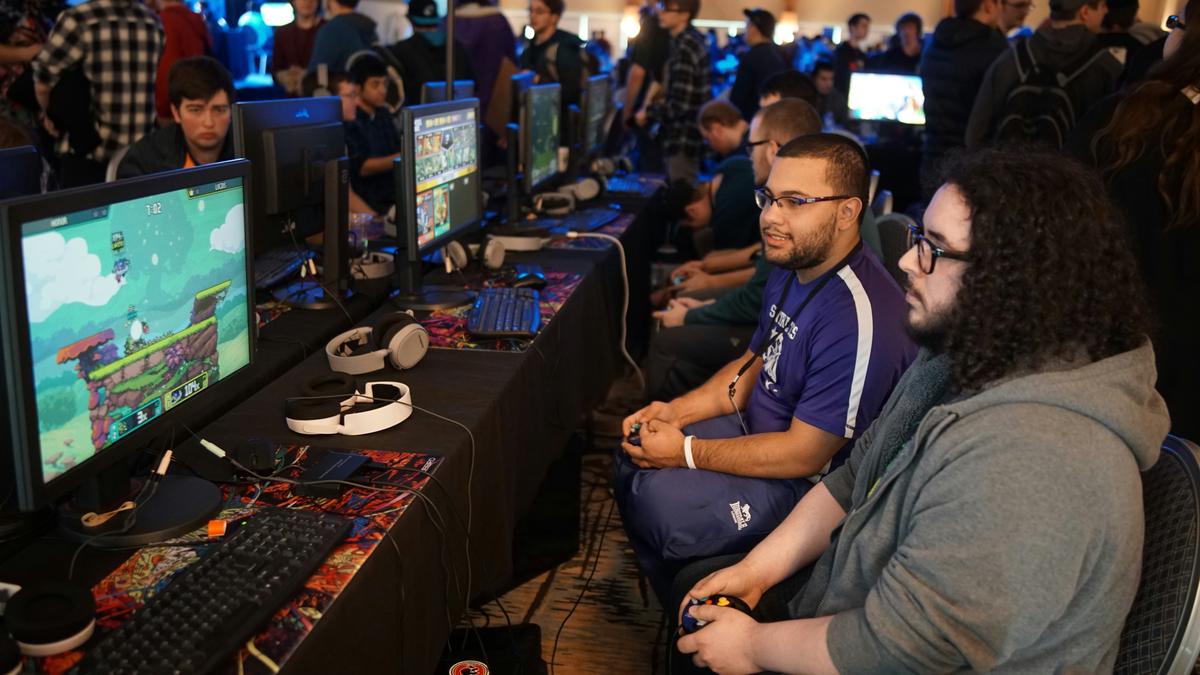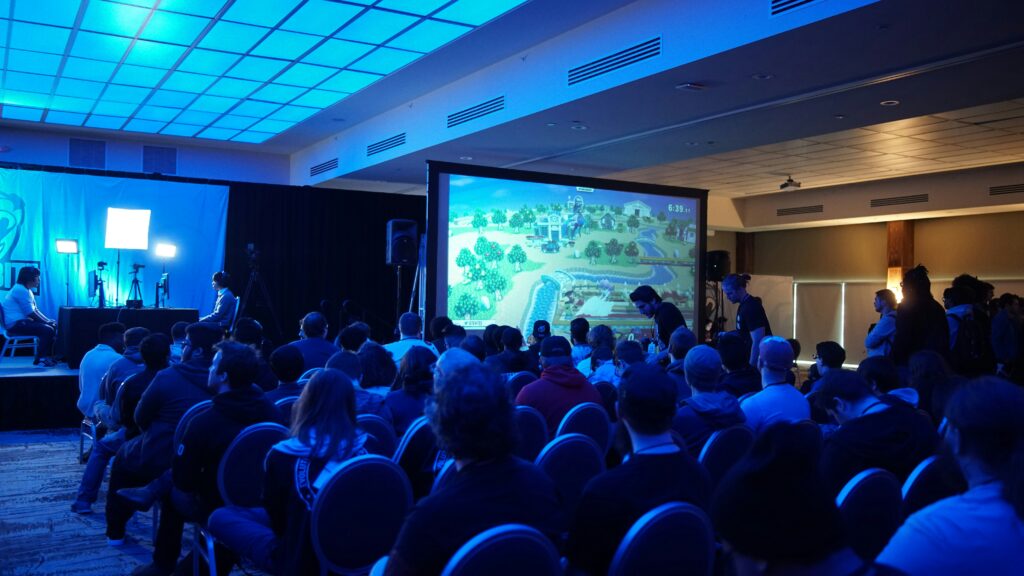Gone are the days when video games were mere pastimes confined to arcade corners and living room TV screens. The evolution of esports has catapulted this digital competition into the global spotlight, establishing itself as a powerhouse in the entertainment industry. From the earliest arcade showdowns to today’s grandiose international tournaments, esports has traversed an extraordinary path to mainstream prominence.
This surge has not only transformed how games are played and viewed but has also redefined athleticism and competition in the digital age. As we delve into the rich history, significant economic strides, and the cultural tsunami that is esports, it becomes clear that this is not just a trend, but a dynamic industry shaping the future of global entertainment and communal interaction.
The Origins and Trajectory of Esports
The Meteoric Rise of Esports: From Niche Hobby to Mainstream Spectacle
In the beginning, the concept of competitive gaming was virtually non-existent; the realm of video games was a solitary pursuit, confined to arcade halls and living room carpet sessions. However, the virtual seeds were planted, and from these humble beginnings, an entertainment revolution sprouted: esports.

The Origin Story
Esports’ embryonic stages trace back to the earliest gaming tournaments in the ’70s and ’80s, where local enthusiasts competed over high scores in games like Space Invaders. These events were small-scale, passion-led, and garnered little attention. The emergence of the internet in the ’90s, however, turned the table, connecting players across the globe and setting the stage for the first real online competitive experiences.
Technological Advancements: A Catalyst for Growth
In the late ’90s and early 2000s, technological advancements paved the way for more sophisticated games, capable of supporting an online esports infrastructure. Fast internet speeds allowed for real-time, lag-free competition. Streaming technology and platforms emerged, uncovering a spectator aspect that was previously latent.
Cultural Shifts Leading to Acceptance
Esports initially skirted the peripheries of cultural acceptance, often misconceived as ‘just games’. Over time, though, perceptions shifted. The youth demographic, savvy with digital environments, pushed esports into their cultural zeitgeist. Gaming as a profession became more viable, and ‘pro gamer’ is now a legitimate title, pursued with the same fervor as traditional sports careers.
The Role of Game Developers and Investors
Major game developers, sensing potential, began tailoring games for competitive play. Titles like “League of Legends”, “Dota 2”, and “Counter-Strike” became not just games, but spectacles designed for esports. They were complex, strategic, and watchable. Investors and sponsors saw the burgeoning crowds and revenue potential, leading to massive prize pools and financial incentives for players and teams.
From Online Streams to Stadiums
Esports’ popularity crescendoed from online platforms to arena-filling events. The 2013 “League of Legends” World Championship sold out the Staples Center in Los Angeles—an unfathomable notion just a decade prior. This normalized the viewing of esports on equal footing with traditional sporting events, even making headway into mainstream television broadcasting.

Emergence of Esports Ecosystem
With acceptance came an ecosystem. Just like traditional sports, esports gave rise to coaches, analysts, and even dedicated training facilities. Scholarships for collegiate esports athletes and the formation of high school leagues provided a structured pathway toward a professional esports career.
The Future: Integration and Industry Growth
Today, the line between esports and traditional sports blurs even further. Traditional sports franchises own esports teams, and crossover events are commonplace. The industry is ripe for continued growth, with VR and AR on the horizon offering new avenues for immersive competitive experiences.
In sum, the transition from obscurity to prominence for esports is a testament to the power of community, accessibility, and the relentless advancement of technology. The trajectory remains ascendantly steep, and as the digital world evolves, so too does the realm of esports, ever onward into mainstream ubiquity.
Economic Impact and Growth of Esports
A Look into Gaming’s Record-Shattering Growth
Esports has transcended its niche origins to become a global phenomenon, smashing economic records and making a profound impact in the world of competitive entertainment. The numbers are staggering, and they speak volumes about the trajectory of this digital colossus.

First, let’s talk about revenue. The esports market is hurtling towards surpassing the billion-dollar mark, with recent projections anticipating revenues close to $1.8 billion by 2022. This surge isn’t just from ticket sales for those world-renowned stadium events. It’s a conglomerate of media rights deals, advertising, and merchandise that stacks the financial deck in esports’ favor.
Sponsorships alone have turned into a gold mine, with major brands that previously poured funds into traditional sports now diving headfirst into the competitive gaming arena. Tech giants, beverage tycoons, and even automotive manufacturers are all scrabbling for partnerships that grant them access to the highly coveted demographic of young, engaged viewers.
Let’s not overlook the prize pools either. The International, Dota 2’s flagship event, shattered records with its staggering prize pool, exceeding an eye-watering $40 million. This isn’t just a jackpot for the players; it’s a signal flare to the world that esports is in the big leagues, competing with top-tier sporting events in terms of payouts.
Streaming and broadcasting rights are another economic stronghold reinforcing esports’ market position. Platforms like Twitch and YouTube have become the colosseums of the modern age, with rights deals growing in complexity and value, showcasing esports’ immense drawing power and the audience’s insatiable appetite for live content.

Esports’ contribution to job creation cannot be understated. With the advent of professional teams come surrounding support jobs – not just coaches and analysts, but also roles in event management, marketing, graphic design, and tech support. This computational ecosystem creates a ripple effect in the labor market, as every professional gamer’s seat represents a multitude of opportunities for ancillary support.
Last but not least, educational institutions are jumping on the bandwagon, recognizing esports as not just a recreational pursuit but also a career opportunity. Universities are offering scholarships to top gamers, further legitimizing the industry and demonstrating its growing impact not just economically but socially, as a valued and respected profession.
In observing these milestones, it’s clear: esports’ growth isn’t just booming—it’s redefining the economic model of sports and entertainment, forging a digital empire that shows no signs of slowing down. As it continues to level up, one thing is certain – the game has changed forever, and it’s an exciting time to be a part of this virtual revolution.
Technological Advancements Shaping Esports
High-Fidelity Game Streaming: A Catalyst for Accessibility
One cannot overlook the monumental impact that game streaming technology has had on the proliferation and accessibility of esports. With platforms like Twitch and YouTube Gaming, high-fidelity streaming has become the standard, bringing live competitive gaming to audiences anywhere, and at any time. The lower latency and higher frame rates available today make watching esports a seamless and immersive experience, akin to the gameplay quality competitors experience in real time.

Advanced Networking Infrastructure: The Backbone of Esports
As players duke it out in virtual arenas, the quality of their connection can mean the difference between victory and defeat. The development of sophisticated networking solutions, including the rollout of 5G and the implementation of dedicated gaming servers, has drastically reduced lag and improved synchronicity. For a professional gamer, this advancement is not just convenient—it’s essential. More importantly, these networking upgrades have democratized the esports experience, allowing competitors from different regions to participate on a more even playing field.
Artificial Intelligence and Big Data: Changing the Game
Artificial intelligence (AI) and big data have transformed how games are played, watched, and analyzed. AI-driven analytics tools now parse through vast amounts of player and game data, offering insights that drive strategic gameplay and training regimens. This has led to the cultivation of a more analytical approach to competition, where decisions are increasingly data-driven. AI also enhances the viewer’s experience by providing real-time stats and predictive insights that add depth to the spectacle.
Esports Hardware: Performance Meets Ergonomics
What is a warrior without a sword? In esports, high-performance gaming hardware is a requisite, not a luxury. From mechanical keyboards to high-DPI mice and ultra-responsive gaming monitors, the hardware is specifically tailored to give competitors the edge they need. Moreover, ergonomics have begun to play a crucial role, as these devices are designed to reduce strain during long hours of play, safeguarding players’ health and endurance.
Virtual Reality: A New Frontier for Interaction and Immersion
Virtual reality (VR) is a burgeoning field within the tech and gaming industry with tantalizing potential for esports. Though still in its infancy relative to other technologies described here, VR brings an unprecedented level of immersion and could redefine audience engagement and competitive gaming structures in the future. It provides a tantalizing hint at a future where physical presence in a stadium is no longer necessary to feel the adrenaline rush of being ‘in’ the action.
Blockchain and Esports: The Advent of Decentralized Gaming Economies
Though not yet mainstream in esports, blockchain technology is poised to revolutionize the industry. Beyond potentially introducing novel ways to handle wagers and prize payouts via cryptocurrencies, blockchain can enable true ownership of in-game assets and herald a new era of fan interaction. Players could soon trade digital goods with absolute security and transparency, further feeding the esports economic machine.
In conclusion, as these technological innovations continue to evolve, they push the boundaries of what’s possible in esports. The effects are not merely enhancements to the user experience but fundamental shifts in the nature and economics of competitive gaming. The trajectory is clear; as technology advances, so too will the gravity and reach of esports. The industry stands on the precipice of unprecedented expansion, with technology as its most potent ally.
Esports Culture and Community Dynamics
Cultivating the Nexus: How Culture and Communities Bolster the Esports Phenomenon
As we navigate further into the intricate web of the esports phenomenon, it’s essential to examine the symbiotic relationship between culture, communities, and the meteoric rise of this digital coliseum. Far beyond a niche hobby, esports has spawned a cultural renaissance and a community-driven force that feeds its colossal growth.

Communities – The Lifeblood of Esports
Let’s cut right to the chase – without communities, there would be no esports. These are not just groups of gamers; they are tech-savvy, highly engaged audiences that breathe life into the games they play. Online forums, social media platforms, and streaming services like Twitch and YouTube Gaming have served as incubators for these fervent communities. Here, they share strategies, celebrate new talent, and foster a competitive yet inclusive environment that has been pivotal in pushing esports into the limelight.
These communities function as a grassroots movement, creating and organizing local competitions that often blossom into international tournaments. They are the true marketers of esports, and their organic word-of-mouth promotion is far more valuable than any large-scale advertisement campaign.
Culture – The Shaping of Identity and Inclusivity
Esports culture has smashed through traditional stereotypes, crafting its own identity where strategic intellect and digital dexterity reign supreme. This cultural shift has attracted a diverse group of followers, united by a shared passion for competitive gaming which transcends age, gender, and nationality.
The inclusivity of esports is unparalleled. Anyone with internet access and adequate hardware can join the fray, blurring the lines between amateur and professional as talent, not background, dictates one’s rise in the ranks. This democratization of sport has widened the playing field, drawing in participants and viewers en masse.
Universities and educational institutions around the world now embrace esports scholarships and varsity programs, acknowledging both the demand and legitimacy of this new era of competition. This academic recognition validates the esports culture and its importance to the new generation.
Localization and Personalization – A Strategic Play
In the move towards the mainstream, esports has seen a localization effort that mirrors traditional sports. Teams and leagues are based in specific cities or regions, sparking local pride and a deeper sense of connectivity between players and fans. This strategic localization engenders a personal investment in the success of teams, not unlike the allegiance to a home city’s football or basketball team.
Esports events now swoop into local economies like any major sporting event, with cities competing to host tournaments that can pump millions into the local economy from fans flocking to catch a glimpse of their digital gladiators’ live.
Inclusivity and Expansion
The personalization doesn’t end there. Accessibility options and adaptive technologies have flung open the doors to players with disabilities, ensuring no one is sidelined in the digital arena. As technology races forward, the barriers to entry are dismantled, nurturing an all-inclusive environment that champions diversity and equal opportunity.
The Future – A Collective Effort
Looking ahead, the continued evolution of esports rests on the shoulders of these passionate communities and the evolving culture they cultivate. As an industry built on the cutting edge, the propulsion towards an increasingly connected and technologically advanced society bodes well for the future of esports. The combined strength of culture and community not only underpins its current success but is also the catalyst for its boundless potential. As this dynamic intersection of technology, culture, and community continues to expand, one thing is crystal clear – esports has only just begun its global conquest.
Mainstream Integration and Future Outlook of Esports
Monetization Models Shaping the Esports Ecosystem
The monetization of esports is not just an incidental feature but a pivotal factor in its mainstream success. As the ecosystem matures, unique monetization models are emerging, reshaping the industry’s financial landscape. Unlike traditional sports, esports revenue generation extends well beyond fixture events. Here’s how the future is shaping up:

In-Game Transactions: A Virtual Goldmine
The financial backbone of many modern titles, in-game transactions, is also integral to esports profitability. Custom skins, character enhancements, and exclusive content engender a loyal paying audience. Publishers are mastering the art of creating a continuous revenue stream by aligning esports excitement with in-game purchasing opportunities.
Ad-Tech Innovations
With a tech-savvy demographic, esports is ripe for ad-tech innovation. Expect to see sophisticated targeting and user engagement, marrying real-time data analytics with interactive advertising formats unique to game streaming platforms. Programmatic advertising will allow brands to place ads dynamically based on viewer preferences and behaviors, maximizing the impression impact.
Esports Betting: An Unfolding Frontier
Esports betting is fast becoming a heavyweight in the industry. As regulators gradually recognize esports as a bona fide betting category, expect a surge in the establishment of formal betting platforms. This opens up a dual revenue stream – for the platforms themselves and through partnership deals for event organizers.
Fan Tokens and Engagement
Blockchain-based fan tokens are the new frontier, offering a novel way for fans to connect with their favorite teams. These digital assets enable voting on minor team decisions, exclusive access to content, and in-person event perks. The tokenization of the fan experience transforms passive viewership into an active, revenue-generating community.
Hybrid Event Models
Hybrid esports events that combine virtual and in-person experiences will become the norm, allowing for broader reach and monetization. These events mitigate location dependency and maximize commercial opportunities by enabling more sponsorship layers and innovative e-commerce integrations.
Education and Brand Partnership Synergies
More esports curricula in colleges will be developed in partnership with industry brands, combining education and product marketing. These programs will serve as feeders for both talent and brand loyalty, crafting the future workforce while embedding product ecosystems into the learning process.
Localized Tournaments and Leagues
Hyper-localized tournaments resonate with regional audiences, driving deep fan engagement. These events encourage local sponsorships and partnerships, providing a nuanced revenue model that goes beyond broad, international sponsorships.
Ultimate Accessibility: Cloud Gaming and Cross-Platform Play
With cloud gaming services on the rise, the barrier to entry for high-end gaming experiences is lowering. Esports titles that can be played across multiple platforms and devices expand the audience base, leading to larger pools of participants and viewers – a magnet for advertisers and sponsors.
Cross-Promotional Synergies
Cross-promotion between esports and other entertainment sectors will intensify. Picture music album launches within esports events or film promotions through in-game content. These synergies extend monetization opportunities into new waters, tapping into cross-domain budget allocations.
Conclusion:
Esports is steering into mainstream consciousness, armed with innovative monetization strategies that are as diverse as the games at its core. The symbiosis of technology, culture, and commerce ensures that the industry’s foundation is not only poised for growth but also for a profound transformation of the interactive entertainment landscape. From in-game economies to localized events, and from hybrid models to betting markets, esports is defining its own future, one in-game purchase, and one fan token at a time.
The tapestry of esports is complex and ever-evolving, painted with the contributions of countless individuals whose passion transcends the virtual arenas. As we peer into the horizon, the fuse of technology and tenacity promises a spectacle that might soon rival traditional sports in breadth and devotion.
Esports is more than just a testament to our competitive spirit; it is a beacon of innovation and community, forever altering the landscape of competition and camaraderie. As the boundaries between the digital and physical worlds continue to blur, esports stands on the vanguard, not only defining a new era of entertainment but also forging an inclusive community that celebrates diversity, strategic intellect, and the unyielding pursuit of excellence.

Hi, I’m Nathan Cross, a writer and avid reader who loves crafting articles for newspapers and online platforms. Words are my passion, whether I’m telling stories, sharing insights, or sparking conversations. When I’m not writing, you’ll find me lost in a book or out on the baseball field, enjoying the game that keeps me grounded. Writing, reading, and baseball—these are the things that define me.



